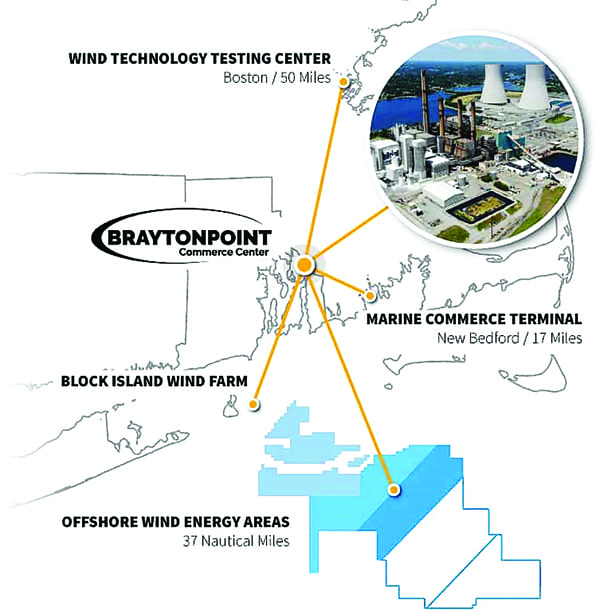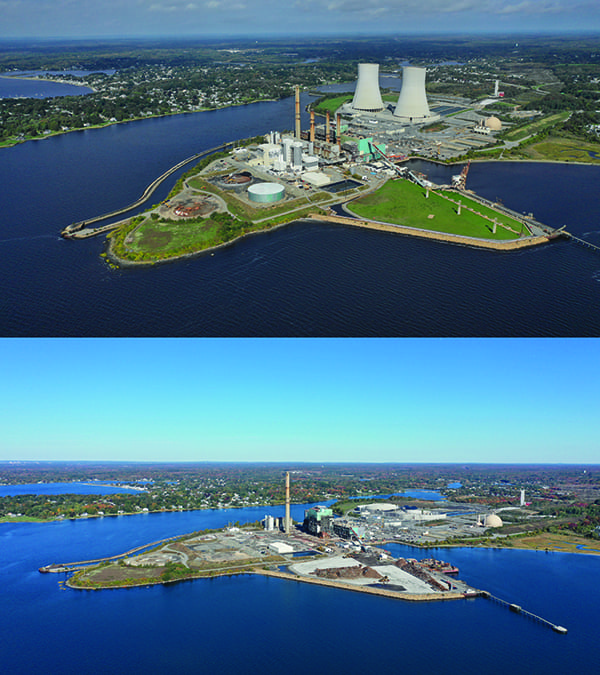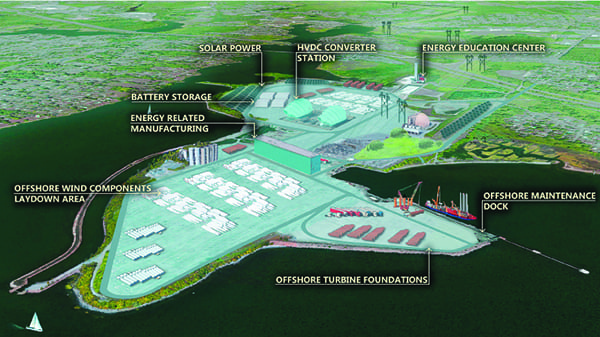The former Brayton Point coal plant’s transformation into an East Coast logistics and manufacturing center, renewable energy hub, and international seaport is a symbolic milestone representing the first of its kind in the U.S. Instead of developing new energy centers subject to uncertainties, the combination of this brownfield conversion, using existing assets and new investments, provides important catalysts for sustainable redevelopment.
Facing steep competition from renewable energy and natural gas-fired generation, the four-unit, 1,600-MW Brayton Point coal-fired power plant located in Mount Hope Bay on the southern coast of Massachusetts was shuttered in 2017. Located approximately 50 miles from Boston and 17 miles from New Bedford, it was the largest coal plant in New England, and the last coal plant in Massachusetts that provided power to the regional grid.
From the start of construction in 1957, followed by commissioning in 1963, the station used coal, oil, and natural gas as fuel sources during its lifetime. At its peak, Brayton Point employed more than 350 staff, providing electricity to 1.5 million homes, while generating more than $12 million annually in property taxes to the Town of Somerset.
While this is a somber ending to its more than half-century run, the story does not end here. Because of the existing electrical grid infrastructure—consisting of a large transformer field, substation, and 115-kV and 345-kV transmission lines—and its status as a regional power hub connecting the area to the larger New England system, it made perfect sense to leverage and rejuvenate the property, as interest grows in the offshore wind energy sector.
Thinking Ahead
A 2014 study commissioned by the Massachusetts Clean Energy Center (MassCEC) identified the 307-acre Brayton Point site as one of the best interconnection points for offshore wind. There are many advantages to this industrial-zoned area, including:
- ■ High-voltage transmission infrastructure that could accommodate up to 2,000 MW of offshore wind at an estimated cost of $20 million with minimal investment in new land-based transmission facilities.
- ■ Public and transportation infrastructure systems (such as access to I-195).
- ■ A deep-water port.
- ■ A crane bay equipped with two 100-ton cranes traversing the length of the building (about 630 feet) previously used for moving plant components into the power house.
- ■ Lay-down yards from five to 150 acres in size.
- ■ Proximity to MassCEC’s Wind Technology Testing Center (about 50 miles).
- ■ Proximity—about 37 nautical miles—to the leading edge of the offshore wind energy areas located south of Martha’s Vineyard.
Getting power generated from offshore wind turbines to shore could be accomplished by underwater transmission cables through Narragansett Bay and Mount Hope Bay, making landfall at Brayton Point. The cables could then interconnect with the existing electrical infrastructure at the site. Direct benefits from this proposition would be:
- ■ Preserving electric system reliability by ensuring generating resources are available to meet customer demand as regional coal, oil, and nuclear plants retire.
- ■ Restoring a local tax base, while supporting energy diversification.
- ■ Hiring key employees from the seller to assist with the transition.
Legislation Promoting Renewable Energy
Over the past decade, climate change legislation has been promoting renewable energy. In August 2008, the Global Warming Solutions Act (GWSA) was signed into law, making Massachusetts one of the first states in the nation to move forward with a comprehensive climate change regulatory program. The GWSA requires a 25% reduction in greenhouse gas emissions from all economy sectors below the 1990 baseline emission level by 2020, and at least an 80% reduction by 2050. Just meeting the short-term emission reduction goal of one-quarter by 2020 is not possible without deep emission reductions in the electric sector.
Since 2009, Massachusetts and the U.S. Bureau of Ocean Energy Management have been leading an effort to establish leasing areas for offshore wind south of Martha’s Vineyard (Figure 1). Also, signing long-term contracts, such as 20- to 30-year deals, with renewable energy developers offers financial certainty.
 |
|
1. According to the Massachusetts Clean Energy Center, developers intend to build multiple offshore wind projects off the coast of Massachusetts, projected to be operational in the early 2020s. Additional offshore wind projects are proposed for sites off the coast of New York, New Jersey, Delaware, and Maryland. All of this development interest adds up to a significant pipeline of offshore wind projects in the region, beginning with Massachusetts’ commitment of 1,600 MW over the next 10 years. Courtesy: Brayton Point Commerce Center |
Then, on Aug. 8, 2016, Massachusetts Gov. Charlie Baker signed into law a major energy bill that amounted to the largest commitment of any state in the nation to offshore wind, thereby setting the stage for Massachusetts as a major hub for the offshore wind industry. An Act Relative to Energy Diversity (H. 4568) requires Massachusetts electricity distribution companies to procure 1,600 MW of cost-effective offshore wind energy by June 2027.
The first competitive solicitation occurred in June 2017. In 2018, Massachusetts passed the Clean Energy Future Act, which added requirements for an additional 1,600 MW of offshore wind procurement. This bill also included a separate request for proposal for transmission lines to connect to offshore wind farms.
Purchase and Transformation
POWER spoke to John Kowalik, director of Marketing and Public Relations with brownfield developer Commercial Development Company Inc. (CDC). The company, through its affiliate Brayton Point LLC, purchased the Brayton Point Power Station (Figure 2) in January 2018. After carefully weighing the value of this new development, CDC and its partnering companies have been investing significant resources to redevelop the site. For example, as part of the transaction, CDC affiliate Environmental Liability Transfer Inc. (ELT) manages the environmental liabilities at the retired power plant site (see sidebar).
 |
|
2. The image on top shows the Brayton Point site in October 2018. It was in early stages of demolition at the time, but still included four power generation units, two 500-foot cooling towers, waste water treatment impoundments, a 9-acre coal storage yard, ash recycling/storage facilities, three ash ponds,11 onsite landfills, and numerous empty fuel storage tanks with miles of associated piping. The previous owner had removed all residual coal prior to transferring ownership; however, limited amounts of fly ash and bottom ash remain, which will be beneficially reused. The image on the bottom is from October 2019. It shows progress that has been made preparing the site for redevelopment. Courtesy: Commercial Development Company Inc. (CDC) |
The final envisioned decommissioning goal is typically complete structural demolition and unrestricted release of sites from regulatory control, allowing public accessibility. While achieving a “greenfield” state can be technically and economically demanding, developers and investors are ready to invest in new projects when environmental liabilities are effectively managed and resolved.
|
Teaming Partners and Accomplishments Since 2014, Commercial Development Company Inc. (CDC) and its affiliates have acquired retired power plants in the U.S. representing 3,300 MW of generation capacity from companies such as Dynegy, American Electric Power, DTE Energy, Alliant Energy, and others. CDC’s portfolio represents more than 300 brownfield properties (such as closed power plants, steel mills, and manufacturing plants) in the U.S. and Canada. The company has assumed almost $2 billion in environmental liabilities, with more than 90% of those liabilities already reaching final remedial milestones. ELT’s executive management has an active member on the U.S. Environmental Protection Agency’s Superfund Task Force and the U.S. Department of Energy’s Environmental Management Advisory Board. In 2018, CDC affiliate Industrial Demolition LLC posted a record year with the razing of 6.5 million square feet of retired industrial space. |
Kowalik said, “Brownfield redevelopment is the most underappreciated element to the global sustainability mix. After a power plant closes, the environmental impact from historic operations still needs to be resolved. Without a strategic plan of action, retired power plants are at risk to remain in a perpetual state of decay and deterioration. Our goal is to purchase these plants, resolve the environmental impact, and repurpose them as new sustainable assets.”
The former Brayton Point owner sold the property to CDC, which has the capability to provide fair market value for existing real estate assets and redevelop the site, while taking on legacy environmental liabilities. That transaction set the stage for the large-scale cleanup and infrastructure redevelopment plan, extending the productive mission of land dedicated to energy production. Known as Brayton Point Commerce Center, the site will be capable of component manufacturing, staging, operations, and maintenance for offshore wind, as well as other sectors. The tools and incentives supporting this purchase follow.
Insurance. CDC purchased for the former owner a $20 million Pollution Legal Liability and Excess of Indemnity insurance policy. Because the discovery of previously unknown contamination can significantly impact budget, this insurance guaranteed coverage, preventing any disruptions subsequent to the transfer.
Contractual Indemnities. Brayton Point LLC indemnified the transferor for onsite and offsite contamination (where the source originated onsite); for past, present, and future contamination; for contamination above and below grade; for natural resource damages; and for third-party bodily harm.
State Voluntary Cleanup/Brownfield Program. Because there were many site areas requiring active remediation, or long-term monitoring and maintenance, the Massachusetts Brownfield program provides a “covenant not to sue” to a prospective purchaser. The program provides liability relief in exchange for a commitment to clean up a contaminated site in accordance with the Massachusetts Oil and Hazardous Material Release Prevention and Response Act and the Massachusetts Contingency Plan, and to undertake an Eligible Brownfields Project, or a project that contributes to the economic or physical revitalization of the community or provides a public benefit to the community.
Bona Fide Prospective Purchaser. The Brownfields Amendments under the Comprehensive Environmental Response, Compensation, and Liability Act (CERCLA) establish the bona fide prospective purchaser provision, providing statutory protection from CERCLA liability for entities that purchased a contaminated facility after Jan. 11, 2002, with knowledge of the contamination.
Site Status
Retiring and decommissioning coal plants is becoming a frequent occurrence (see “Removing Asbestos and Regulated Materials Key to Power Plant Decommissioning” in the October 2019 issue of POWER). To date, the Brayton Point site has completed various decommissioning obligations that were transferred to and managed by ELT. They include:
- ■ Asbestos and universal waste abatement.
- ■ Demolishing two 500-foot-tall cooling towers.
- ■ Crushing onsite concrete for beneficial reuse as surface grading material.
- ■ Recycling metal demolition debris.
- ■ Site re-grading following demolition activities.
There are 11 lined landfill cells, which accepted oil ash and power plant sludge generated by the power plant. All were constructed in compliance with Massachusetts Solid Waste Regulations. Ten of the cells are capped and closed, or in the process of being closed. Land-use controls include ongoing post-closure monitoring for the closed cells, groundwater monitoring on a quarterly basis, and surface water monitoring on a semi-annual basis.
Converter and Energy Storage. In May 2019, Anbaric announced major investments at the Brayton Point site that will include a 1,200-MW high-voltage direct-current (HVDC) converter, estimated at $250 million, and 400 MW of battery storage, an additional $400 million investment (Figure 3).
 |
|
3. The Anbaric Renewable Energy Center will include a 1,200-MW high-voltage direct-current (HVDC) converter and 400 MW of battery storage on the Brayton Point Commerce Center site. Courtesy: Anbaric |
“The Renewable Energy Center represents Anbaric’s broader vision for its Massachusetts OceanGrid project: high-capacity transmission infrastructure to maximize the potential of the region’s offshore wind energy resource,” Anbaric CEO Edward Krapels said in a press release announcing the project. “As Massachusetts considers harnessing more offshore wind, the right infrastructure needs to be envisioned and set in motion. An HVDC substation is an important piece not only for Brayton Point Commerce Center, but also Massachusetts’ status as a leader in offshore wind.”
Anbaric’s prospective investment is encouraged by the 2018 legislature to treat transmission for offshore wind separate from generation, thus encouraging larger-scale projects with bigger local economic impact, an important item for the Town of Somerset, which is looking to replace lost tax revenue from the closed coal-fired facility.
Marine Commerce Terminal and Reducing Environmental Impacts. The U.S. offshore wind industry will need significant physical port, waterfront, and shipping infrastructure to be successful, because proximity translates into cost savings. Brayton Point is equipped with one of the largest available waterfront acreages in the northeast, and a deep-water port capable of berthing domestic and international merchant vessels. Once used to import coal, the marine terminal is being repurposed to handle project vessels, dry bulk carriers up to 64,000 deadweight tonnage (the maximum weight that a ship can carry).
For example, a significant milestone was the first cargo shipment received at the site’s newly redeveloped marine commerce terminal on Sept. 25, 2019. This particular shipment consisted of 30,000 metric tons of de-icing salt imported from the Atacama Desert region of Chile. Although offshore wind in Massachusetts will not go online until 2023, the Brayton Point Commerce Center will be able to begin heavy-lift port operations by early 2020.
Furthermore, an equally significant deal was struck in June 2019 with the announcement of a port operations and lease agreement with Patriot Stevedoring + Logistics LLC (Patriot). Patriot is a joint venture between Carver Stevedoring Services Inc. and Pangaea Logistics Solutions Ltd. for the purposes of managing port operations at Brayton Point Terminal. With this agreement, Patriot will manage marine commerce terminal operations and create a regional logistics port with global distribution capabilities.
Renewable Energy Training Center. Growth in the renewables sector will require a new skilled workforce in New England. As part of the Brayton Point redevelopment plan, CDC will be repurposing a closed coal gasification facility as an onsite renewable energy training center, providing a platform for offshore wind installation, maintenance, welding certifications, and a 200-foot silo for simulating offshore wind towers.
Blade Testing. MassCEC’s Wind Technology Testing Center offers turbine blade certification testing and prototype development. For example, IEC 61400-23:2014, Wind turbines – Part 23: Full-scale structural testing of rotor blades, defines requirements for full-scale structural testing of wind turbine blades, including interpretation and evaluation. Among the requirements are:
- ■ Static load tests.
- ■ Fatigue tests.
- ■ Static load tests after fatigue tests.
- ■ Tests determining other blade properties.
The purpose of the tests is to confirm to an acceptable level of probability that the whole population of a blade type fulfils the design assumptions.
Fulltime Jobs. Construction activities are expected to occur over two-year periods, and operations and maintenance (O&M) activities throughout the lifecycle of wind farms, which is typically 25 years. In total, O&M activities are projected to support between 917 and 1,748 total fulltime-equivalent jobs annually, including indirect and induced impacts. Bristol Community College, Cape Cod Community College, Massachusetts Maritime Academy, University of Massachusetts Amherst, University of Massachusetts Lowell, Greenfield Community College, and New England Institute of Technology are positioned to train and educate candidates, providing pathways into wind energy sectors.
With state-wide mandates for offshore wind energy generation, proximity to offshore wind tracts in the Atlantic Ocean, port access, training centers, favorable zoning, certification testing and prototype development, and access to a highly skilled workforce in the New England area, it becomes clear that the renewable energy sector will play a key role in Brayton Point’s future. ■
—James M. Hylko (JHylko1@msn.com) specializes in safety, quality, and emergency management issues and is a frequent contributor to POWER.
https://www.powermag.com/redevelopment-project-converts-site-from-coal-to-renewables/?pagenum=6